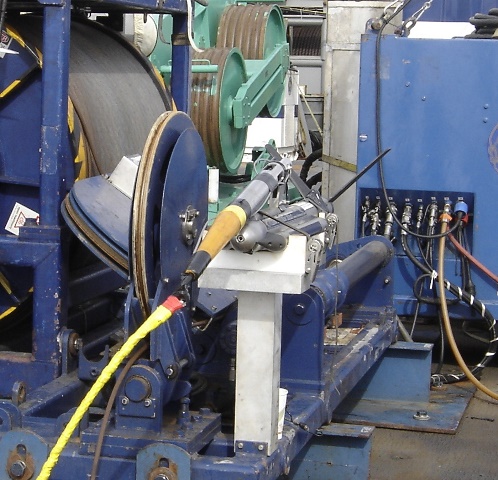HUGIN 54 AUV
SUPSALV’s Hugin 54 AUV (known as Trondheim) is an autonomous underwater vehicle capable of long duration, highly accurate, autonomous underwater searches to a depth of 6,000 meters (20,000 FSW).

The system consists of the autonomous vehicle, a launch sled, and an operations and maintenance van. SUPSALV’s newest AUV is capable of sonar searches, multibeam mapping, sub-bottom profiling, magnetic sensing, and high resolution still camera observation.
The vehicle can operate in three modes; Autonomous, Supervised and Trajectory mode. The autonomous mode has no operator input and the vehicle follows a preplanned route with up to 50-hours of run time. In supervised mode, the operator receives real-time payload data for quality management purposes
The Hugin AUV is equipped with acoustic communication links providing real time status monitoring of the vehicle, its position, and payload sensor functioning. The acoustic links also add the capability to receive payload data from the vehicle in real time as a quality measure, ensuring an effective survey.
SUPSALV’s Trondheim’s payload, the Synthetic Aperture Sonar is equipped with HiSAS 2030 technology High Resolution Interferometric Synthetic Aperture Sonar with a resolution of 4cm x 4cm and a 300 – 600 m swath for a daily coverage of 4 – 10 nm2. The system is air transportable and can operate from any capable platform of opportunity
GENERAL SPECIFICATIONS
VEHICLE:
- Length - 23 ft (7m)
- Diameter - 2.5 ft (0.75m)
- Weight - 4359 lbs (1977kg)
PERFORMANCE
- Depth: 6000m of seawater)
- Nominal Survey Speed: 3.8 knots
- Battery Capacity: 48kWh
- Operational Endurance: 53 hrs at 3 knots
- Charge Time: 8hrs from full discharge
NAVIGATIONAL CAPABILITIES
- Autonomous
- Supervised
- Trajectory
INSTRUMENTATION
Navigation and sensors
- Honeywell HG9900 Inertial Measurement Unit
- Leica DMC compass
- Novatel AUV GPS Receiver
- Seapath 330 Topside GPS Receiver
- DigiQuartz Depth Sensor
- Kongsberg Mesotech AltimeterImagenex Forward Looking Sonar
- Nortek 500 Doppler Velocity Log
- SAIV Oceanographic DTD
PAYLOAD
- Sonar - Synthetic Aperture Sonar HiSAS 1030 w resolution of 4cm x 4cm for full area and 2cm x 2cm for spot processing. 300 – 600m swath, 4-10 nm2 coverage
- Multibeam - KM EM2040 200 – 400 kHz Multibeam Echosounder .7° x .7° resolution. 15-400m swath (altitude driven)
- Sub-Bottom Profiler – EdgeTech SBP 106 (1-6kHz) and 216 (2 – 16kHz)
- Camera – Cathx M12 A1000 F1.4 camera 6500m (photo) with laser line scan.
- Turbidity Sensor – WetLabs FLNTU ECO Puck,
- Magnetometer – Ocean Floor Geophysics Self-Compensating Magnetometer, 6K
- Mag Coverage – 15m per 100kg steel
Shallow Water Intermediate Search System (SWISS)
SWISS is a towed side scan sonar that meets the Navy's mid-water search requirement down to a maximum depth of 7,000 feet of seawater.

The system consists of the vehicle, fiber-optic tow cable, handling system, generator operations van and a maintenance van. Navigation is accomplished by using algorithms incorporating the amount of cable in the water and the depth indication from the pressure sensor. Electrical power from the support platform can be used for the system if it is compatible; otherwise a generator provides the power.
SWISS is a dual frequency (100/500 kHz) towed side-scan sonar system mounted inside a torpedo shaped tow body. The sonar is towed behind a vessel at slow speeds, generally from 1-5 knots depending on the required depth. Sonar signals are processed producing both an analog and digital display in order to identify potential targets. The low frequency is primarily used for searching for large objects or at long ranges, while the higher frequency provides extremely fine details and operates at shorter ranges.
GENERAL SPECIFICATIONS
Tow Body
- Length - 5 ft
- Diameter - 4 1/2 in
- Weight - 70 lbs>
Performance
- Depth - 7,000 ft
- Tow Speed - 1-5 knots
- Auto Controls - TVG (Time Varied Gain)
Navigation Instrumentation
- Fluxgate Magnetic Compass
- Depth Sensor
- Pitch/Roll
Sonar Range Scales(Simultaneous)
- 100 KHz 75-500 meters
- 500 KHz 25-250 meters
Towed Pinger Locator 25 (TPL-25)
The TPL-25 System meets the Navy’s requirement for locating emergency relocation pingers on downed Navy and commercial aircraft down to a maximum depth of 20,000 feet anywhere in the world.
The system consists of the tow fish, tow cable, winch, hydraulic power unit, generator, and topside control console, although not all of these components are required on every mission. Navigation is accomplished by using algorithms incorporating the amount of cable in the water, the depth indication from the pressure sensor and other parameters. The generator provides electrical power for the system or power from the support platform can be used if it is compatible.
The tow fish carries a passive listening device for detecting pingers that automatically transmit an acoustic pulse. Most pingers transmit every second at 37.5 kHz, although the TPL can detect any pinger transmitting between 3.5 kHz and 50 kHz at any repetition rate. Commercial aircraft pingers are mounted directly on the flight recorder, the recovery of which is critical to an accident investigation.
The Pinger Locator is towed behind a vessel at slow speeds, generally from 1 - 5 knots depending on the depth. The received acoustic signal of the pinger is transmitted up the cable and is presented audibly, and can be output to either a Oscilloscope, or Signal Processing Computer. The operator monitors the greatest signal strength and records the navigation coordinates. This procedure is repeated on multiple track lines until the final position is triangulated.
The current TPL-25 replaces all previous systems; TPL-20, 30, & 40.
GENERAL SPECIFICATIONS
TOW BODY
- Length -30 inches
- Diameter - 35 inches
- Weight - 70 lbs
PERFORMANCE
- Depth - 20,000 feet of seawater
- Speed - 1-5 knots
NAVIGATION INSTRUMENTATION<>
- Depth Sensor
- Pitch, Roll, Heading
Frequency
- Adjustable from 5-60 KHz